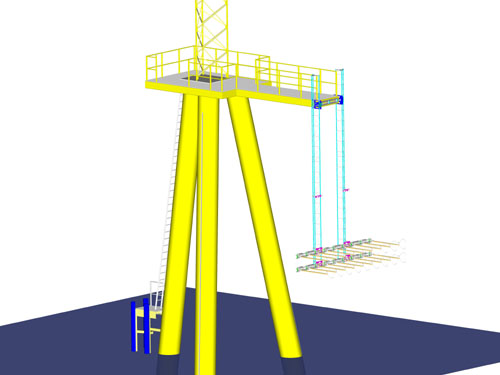 |
| This
computer drawing of the Air-Sea Interaction Tower (ASIT) and
OHATS array shows the vertical legs of the array support structure
in light blue with brackets in darker blue and pink (Created
by Megan Carroll). |
|
The
overall array design was based on a National Center for Atmospheric
Research (NCAR) experiment performed over land in the San Joaquin
Valley of southern California. Since this array would be deployed
over the open ocean, its supporting structures had to withstand
high winds and sea spray commonly encountered at the Martha's Vineyard
Coastal Observatory (MVCO). With that in mind, existing parts from
the NCAR experiment were used and incorporated into the OHATS project
for unpredictable ocean conditions.
The scientist objectives of OHATS
required that a horizontal array of nine sonics be deployed at two
levels in the atmospheric boundary layer near the ocean surface.
The required horizontal separation was 23 inches (0.6m) for a total
span of 183 inches (4.6m). The same separation was required between
the two levels.
The
width of the tower platform where the structure was to be suspended,
often referred to as the diving board, was only 54 inches (1.4m).
That proved to be one of the major limiting design factors. Because
the design needed to incorporate two horizontal arrays with nine
sonics each, the width on either side would have to be about 64
inches (1.6m). This would require assembly of the outside sonics
before placement of the horizontal structure.
Another
concern was the actual amount of working space on the tower. Each
of the 18 sonics had to be brought up to the platform separately
to avoid possible damage. The sonics were then attached to a boom
and carefully clamped to the horizontal structure once in place.
Because of this, it was important to design a system that would
require as few people as possible to assemble and deploy.
|
